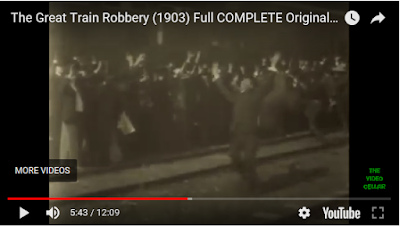Task 1c - Edwin Porter ; "The Great Train Robbery" (1903)
Pioneer of early continuity editing (editing being invisible, make belief)
He worked in the cinemas, preparing the films to be played. Touring with Edison pictures, and realised he could do the same, so he did and made over 250 films. He uses temporal overlaps and a cut on action too. Edwin Porter created 'compressing time' by excluding some unnecessary shots. He attempted to create dissolves and he experimented with cross crossing. Edwin, was one of the FIRST to use close ups to show emotion and detail.
-
-
They used a cross cut into another story. And the jump cut again using a cross cut into another story. An early cut away was used. and they use a temporal overlap, and many jump cuts. Another temporal overlap used but through a cross cut too. The use a mid shot of the guy shooting. They actually attempted in compression of time and they didn't make it like a tableau film like the Lumere brothers, because this film has different angles and shots, at the end they used a mid shot.
The first machine for editing was called the Moviola but this was later in 1924.
-
-
-
-
This part of the movie represents an establishing shot used at 1:26 seconds of the movie, which shows audiences the next scene/location where it will or is being filmed and where the next character/ set of actors may act next. This also sets the scene and also links back to cross cutting because the camera in this part would need to use a scene first and then an establishing shot; which does. This part of the movie adds a cross cut; from one scene of people robbing a guy in a train and then in the next scene it changes to people working next to a ladder.
-
-
-
This part of the movie represents an establishing shot used at 1:26 seconds of the movie, which shows audiences the next scene/location where it will or is being filmed and where the next character/ set of actors may act next. This also sets the scene and also links back to cross cutting because the camera in this part would need to use a scene first and then an establishing shot; which does. This part of the movie adds a cross cut; from one scene of people robbing a guy in a train and then in the next scene it changes to people working next to a ladder.
-
-
Through out most of the screenshots of the movie, each camera angle it set towards the 180 degree rule and is always placed like this, until when they get off the train you can see they use a different camera angle shot. This allows them to walk off set and then be able to successfully create temporal overlaps and jump cuts/cross cutting to next scenes.
-
-
-
-
Edwin also uses the 180 degree rule shown in this shot. And, a 180 degree rule shot is basically when all the cameras being used to film, where set on one side and always one side of the whole film. This is so the characters on scene do not change position throughout the film and so the audience do not get confused.
In this scene they use a gunshot smoke effect, where a guy tries to run away from the robbery and the people shoot him with a gun because u can see after he drops to the ground as smoke appears from the back of him and this was probably a light smoke bomb used to create this effect in the actual film, and was possibly timed to perfection.
Through out most of the screenshots of the movie, each camera angle it set towards the 180 degree rule and is always placed like this, until when they get off the train you can see they use a different camera angle shot. This allows them to walk off set and then be able to successfully create temporal overlaps and jump cuts/cross cutting to next scenes.

-
The final shot of the movie they jump cut to the camera angle of a medium close up shot, which shows the guy shooting his gun repeatedly towards the camera and then it fades to title screen of just 'The End!'.








Your task 1 is excellent Nasir. You've carried out detailed analysis of 3 early film makers and given a really close analysis of how early editing developed. Well done! V
ReplyDelete